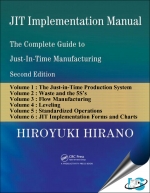Tab Article
The one manual that every corporate executive should read again and again… re-released for the first time in an affordable paperback version
Known as the JIT bible in Japan, JIT Implementation Manual - The Complete Guide to Just-in-Time Manufacturing presents the genius of Hiroyuki Hirano, a top international consultant with vast experience throughtout Asia ans the West. Encyclopedic in scope, this six-volume practical reference provides unparalled information on every aspect of JIT - the waste-eliminating, market-oriented production system. This historic, yet timeless classic is just as crucial in today's fast-changing global marketplace as when it was first published in Japan 20 yeas ago.
Volume 1 : The Just-In-Time Production System
Providing a comprehensive introduction to the just-in-time production system, Volume 1 : The Just-in-Time Production System dispels outdated myths and ideas about manufacturing that are still prevalent. Supplying essential background information on the JIT approach to production management, this user-friendly resource builds a strong foundation for implementation.
Volume 2 : Waste and the 5S’s
Provides a comprehensive overview of the concepts of waste in manufacturing and methods of discovering, removing, and preventing the creation of waste. It also teaches the 5S system, a method for organizing the workplace to eliminate waste, demonstrating how to use red tags for visual control and signboards for visual orderliness. The book also illustrates how to organize jigs and tools.
Volume 3 : Flow Manufacturing : Multi-Process Operations and Kanban
Covering all the techniques essential to setting up a flow production system in manufacturing Volume 3 : Flow Manufacturing - Multi-Process Operations and Kanban includes a basic introduction to the relationship between inventory and flow production and their roles in manufacturing. It also provides discussion of multi-process operations and precautions and procedures for developing them. Outlining the key topic of labor cost reduction and steps to achieving it, this definitive volume also covers the essentials of kanban and visual control systems in a flow manufacturing environment.
Volume 4 : Leveling : Changeover and Quality Assurance
Provides essential background on the core concept of level production in a JIT, or lean, manufacturing system and the implementation techniques. It also discusses changeover and the rules and procedures for changeover improvement and covers quality assurance in the context of level production, including how to recognize structures that create defects, plan for achieving zero defects, and make use of mistake-proofing devices.
Volume 5 : Standardized Operations : Jidoka and Maintenance/Safety
Providing details on how to implement standardized operations in manufacturing, including essential information on how to establish, improve, and preserve standard operations, Volume 5 : Standardized Operations - Jidoka and Maintenance/Safety covers the key topic of Jidoka, or human autonomation - essentially how to separate human activity from machine work without producing defects. It also addresses the essential aspects of maintenance in a JIT environment and how to prevent breakdowns. The book includes time-saving information on how to quickly recognize why injuries occur and create a strategy for zero injuries and zero accidents.
Volume 6 : JIT Implementation Forms and Charts
Provides a comprehensive diagnostic tool for JIT operations and includes a wealth of checklists, memos, and essential forms for recognizing waste in operations and implementing the 5S's. It includes engineering forms for line-balancing, skills training, visual controls, changeover improvement, mistake-proofing, and standard operations. This indispensable resource also supplies a set of forms and charts useful when introducing and promoting JIT or lean to your plant and includes the JIT management forms that Hirano uses to implement "JIT Awareness Revolutions." This volume include CD-ROM contains pdf versions of more than 40 forms.


